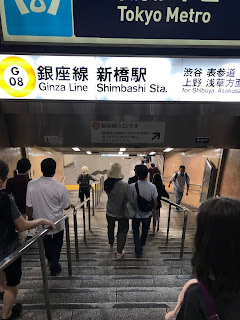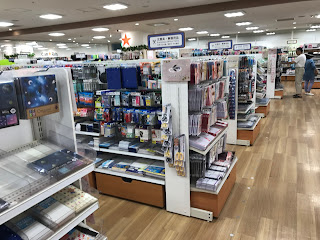During our recent trip to Tokyo we were walking through the outer area of Tsukiji Fish Market when I jumped at the sound of my name. Someone in the distance yelled out, "Ashley!!!" In the middle of this enormous city and this extremely crowded open market, we ran into my co-worker and her family. We had no idea she would be at Tsukiji on that same day. Her first words were, "I thought you said riding the train and subway was easy!!! It's not!!!"
She was absolutely right. It's not a simple task to understand the complex system of Tokyo's trains and subways. We first had guidance from my very dear friend and her husband who live in Japan. After one ride with them, we studied the maps using Hyperdia and asked for verification from strangers along the way until we were successful in using both modes of transportation. My #1 tip is: Do not walk into a station thinking you're just going to wing it. You must have a plan before you leave your hotel room. Always search the route using the Hyperdia app first and take a screenshot. Then head towards the station in case there's a problem with your pocket Wifi while you're away from the hotel.
The Hyperdia app will always give you the fastest route. This will mean switching from train to subway or vice versa. You might not be comfortable riding the train and the subway lines during your first trip. When moving from a JR train line to a subway line, you first have to exit the JR gates and then find the right subway line and enter new gates. This could be at the opposite end of the train station. In some cases, we would exit the station, walk outside, around the building and reenter through another doorway as we followed signs that led us on the right path.
Entering the JR train gates at Ueno Station: Most stations will be filled with travelers as you move with the foot traffic so it's very difficult to stop and read signs. We witnessed several frustrated American families in the train stations arguing or studying the maps. It can be especially difficult when you are not fluent in Japanese.
Entering the Ginza subway line at Shimbashi Station. More stairs!!
Basically, you will need to be aware of all signs and remember the names of the train and subway stops as well as the name of the lines. We were extremely lucky that my husband has a good sense of direction. That always helps too.
This map shows the train system in Tokyo. At first glance I was like, "What???" I could barely see the names of the lines, let alone understand the direction and stops. This is why we mostly visited areas on the Yamanote line on our first trip. This would be the light green line in the center of the map. Look for Tokyo Station and you'll see the awkward oval shape of the Yamanote line. If you miss your stop or are headed in the wrong direction, it travels in a connected oval so you'll get there sooner or later. The drawback of using the Yamanote line is the number of stops which adds to your travel time. These trains are also more crowded at all times of the day.
This is the map that the information desk will give you when asking for help using the Tokyo subway system. Again, the map appears to be a complicated dot to dot worksheet, filled with names and numbers. Knowing the number of the stop you need is also helpful when checking to see that you are moving in the right direction.
On our last trip to Tokyo, there was one day where our Hyperdia App did not function properly. As a backup, I googled the route and was given about 4 different choices of trains and subways. Make sure you choose the picture of the train above the google map. You also need to know the name of the closest station to your destination. Each route will tell you how many minutes you have until the train departs. Remember, if you miss the train, the next one will come in less than 10 minutes (in most cases).
This was my google search for the route from Shinagawa Station to Oshiage Station. This route took me to Tokyo Solamachi or the Skytree Mall. Please note that when it says 5 minute walk, double that number. Speaking from experience, a 10 minute walk usually equates to a 20 minute walk! In some instances, we did a search on Hyperdia and Google to compare different routes in order to be sure we were headed in the right direction.
Hopefully these tips can help you to successfully use the train and subway system in Tokyo. You might also be able to find your own apps that can give you direction in taking the right lines of transportation. Although it takes planning, the children always say that riding the train and subway is a highlight of the trip!










































